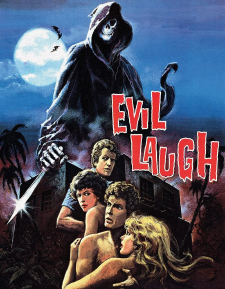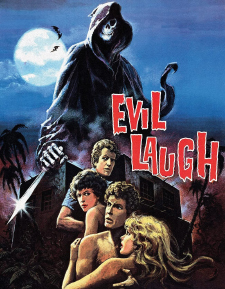Evil Laugh (Blu-ray Review)

Director
Dominick Brascia, Jr.Release Date(s)
1986 (January 31, 2023)Studio(s)
Wildfire Productions (Vinegar Syndrome)- Film/Program Grade: C-
- Video Grade: B-
- Audio Grade: B-
- Extras Grade: B+
Review
Evil Laugh is what happens when a couple of young actors get tired of the runaround from the audition process, and decide to make their own movie instead. It was the brainchild of Dominick Brascia (Friday the 13th: A New Beginning) and Steven Baio (Scott’s brother, who had made appearances on Happy Days and Joanie Loves Chachi). They both wrote and produced it, with Dominick making his debut as director (a point of contention between the two of them, since Baio wanted an experienced director instead). Needless to say, it was an independent production, made on a shoestring, and the lack of funds definitely shows in the final product. While it doesn’t necessarily stand out from the pack, there are still a few points of interest in it. Their story is standard Eighties slasher fare, with a group of medical students staying overnight in a house that was the site of a tragic multiple murder many years earlier. The killer returns(?), and carnage ensues. Yet it does feature a horror movie addict character who keeps questioning everything that’s going on, ten years before Kevin Williamson created Randy for Wes Craven’s Scream (and even five years before Mike in Rolfe Kanefsky’s There’s Nothing Out There). Aside from that, the story doesn’t do very much to break the mold of other genre efforts from the era.
Brascia originally planned to act in the film, but he ended up staying behind the camera instead (though he did provide the “evil laugh” for the killer). Baio did play a major character, joined by Kim McKamy, Tony Griffin, Jody “Babydol” Gibson, Jerold Pearson, Myles O’Brien, and Karyn O’Bryan. It was Gibson’s only acting role, as she would end up changing her name to Sasha, starting an escort service, and becoming known as the Hollywood Super Madam. She wasn’t the only one who changed names and careers, either, as McKamy would go one to much greater success as adult film star Ashlyn Gere. Ironically enough, she refused to do any nudity in the film, and they had to use a body double for her shower scene. (Even more ironically, she would later serve as a body double in mainstream productions like Basic Instinct and Indecent Proposal.) She’s an appealing “final girl,” and could have easily gone on to a career as a Scream Queen had she not decided to go a drastically different direction. Unfortunately, Brascia and Baio decided to take her character a different direction for a needless twist ending, but up until that point, she’s a credibly tough survivor. (Biao actually regrets the finale, though for different reasons.)
It’s not just the actors who ended up changing after things wrapped; the film itself underwent changes as well. Distributor Krishna Shah decided that there wasn’t enough gore and nudity, so even though the final edit was done and a print had already been struck, reshoots were scheduled to add more blood and a bit of T&A. (That’s why the murder of the delivery boy is shot against a simple black background, since it wasn’t filmed at the original location.) Brascia and Baio had assumed that Evil Laugh would go straight to video, but Shah was happy enough with the results of the reshoots that he struck 35 mm blowups for an actual theatrical release. It was hardly a smash success, but it still found its own limited audience, especially once it reached home video. Fortunately, horror movie fans are a generally forgiving lot, and VHS junkies were the most forgiving of all, so there’s always an audience out there.
Cinematographer Steef Sealy (aka Stephen Sealy) shot Evil Laugh on 16 mm film using an Arriflex 16SR camera with spherical lenses. (The 16SR series wasn’t capable of utilizing the Super-16 format until 1992, so this was standard 16 mm.) It’s presented here open matte at the full 1.33:1 frame, though presumably it would have been matted to 1.85:1 for the 35 mm blowups. Vinegar Syndrome describes this version as “newly scanned & restored in 2K from its 16 mm vault elements,” but they also added a title card before the film begins that says that “the only known film element for the movie was a heavily damaged print of the first cut, which did not include the roughly 60 seconds of re-shot gore.” Since the release prints were 35 mm, presumably this means that they used a 16 mm answer print that was struck prior to the reshoots or blowups. The elements for the missing footage couldn’t be located, so inserts from the original video tape master were used instead. They’re definitely identifiable as such, but they integrate with the surrounding film material better than expected. That’s partly because the film itself already looks pretty rough. There’s a fair quantity of scratches and speckling on display, and the fine detail is limited by the resolution of standard 16 mm film, as well as by the moderately heavy grain. The colors and contrast are both pretty solid, with good black levels, but not much in the way of shadow detail visible—the blacks are simply black. The closing credits suffer from some instability, but it doesn’t affect the rest of the film quite as badly. This is definitely the best that Evil Laugh has ever looked on home video, but expectations do need to be tempered by an understanding of what was involved in bringing it to Blu-ray.
Audio is offered in English 2.0 mono DTS-HD Master Audio, with optional English SDH subtitles. The dialogue sounds a bit muffled, with some distortion and excessive sibilance as well. There’s also some persistent hiss and crackling in the background. Everything is still clear enough to be comprehensible, so none of those flaws are too distracting.
Vinegar Syndrome’s Blu-ray release of Evil Laugh includes a reversible insert with the primary poster artwork on the front, and alternate artwork on the back. There’s also an embossed and spot gloss slipcover available directly from Vinegar Syndrome, limited to the first 6,000 units, that was designed by Earl Kessler, Jr. The following extras are included, all of them in HD:
- Audio Commentary with The Hysteria Continues!
- The Joy of Laughter: Making Evil Laugh (87:32)
- Still Gallery (3:34)
The Joy of Laughter is the feature-length documentary about the making of Evil Laugh that you never knew that you needed, and probably never really wanted, either. Live and learn, because here it is, and it’s a lot of fun. It features interviews with Steven Baio, Steef Sealy, producers Joe Barnard and James Daurio, and makeup effects artist David Cohen, as well as actors Johnny Venokur, Jerold Pearson, Karyn O’Bryan, and Tom Schell. They give a nice overview of the production from conception to release, but the real fun is their wild stories about everything that happened on set. Actually, that’s a double-edged sword, since Venokur does offer a particularly distasteful story about telling the body double that she needed “grooming,” and then getting out a tweezers and doing it himself. (Maybe he was just trying to stir the pot a bit, but it doesn’t come off that way.) That’s the exception, though, as most of their tales are far more entertaining than that. In fact, The Joy of Laughter is arguably more entertaining than Evil Laugh is, though fans may disagree.
The commentary features members of The Hysteria Continues! podcast collective, which includes Justin Kerswell, Nathan Johnson, Erik Threlfall, and Joseph Henson. Their primary area of expertise is the slasher genre, so Evil Laugh is definitely right up their alley. They offer their own histories of seeing it for the first time, and then examine the production itself. They assess the homoerotic and supernatural overtones, and the comparisons to both Scream and There’s Nothing Out There. They also examine the careers of the various actors, including McKamy/Gere, who they say makes a credible final girl. (It seems that I’m not the first person to have that exact same thought.) They read from one of the original reviews, which wasn’t exactly laudatory, as well as some of the video guides that have covered the film. Toward the conclusion, they bring up the alleged grooming question surrounding the body double, which isn’t exactly a strong way to end things, but it’s still an informative commentary overall.
The story of Evil Laugh doesn’t end there, since there’s a bit of a postscript about Dominick Brascia. He directed one more low-budget horror film two years later, Hard Rock Nightmare, and eventually went on to a semi-successful career as a radio personality in both Sacramento, CA and Bozeman, MT, before he passed away at the age of 61 in 2018. Toward the end of his life, he became embroiled in the revelations surrounding the sexual abuse of Cory Haim, first as an accuser, and later as one of the accused. Unsurprisingly, none of that is mentioned in any of the extras here, doubtless for solid legal reasons, but it’s still a part of the legacy of the film and its filmmakers. Despite that understandable omission, this is as thorough of a special edition for Evil Laugh as anyone could possibly want. It’s got some nice value-added content that’s worth watching even if you’re not a fan, and the film looks as good as it ever has—probably as good as it ever will, too.
- Stephen Bjork
(You can follow Stephen on social media at these links: Twitter and Facebook.)

